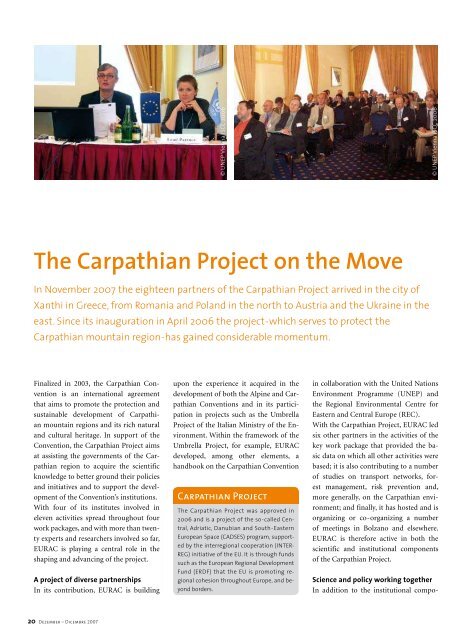Download - EURAC
Download - EURAC
Download - EURAC
Sie wollen auch ein ePaper? Erhöhen Sie die Reichweite Ihrer Titel.
YUMPU macht aus Druck-PDFs automatisch weboptimierte ePaper, die Google liebt.
© UNEP Vienna ISCC 2006<br />
The Carpathian Project on the Move<br />
In November 2007 the eighteen partners of the Carpathian Project arrived in the city of<br />
Xanthi in Greece, from Romania and Poland in the north to Austria and the Ukraine in the<br />
east. Since its inauguration in April 2006 the project - which serves to protect the<br />
Carpathian mountain region - has gained considerable momentum.<br />
Finalized in 2003, the Carpathian Convention<br />
is an international agreement<br />
that aims to promote the protection and<br />
sustainable development of Carpathian<br />
mountain regions and its rich natural<br />
and cultural heritage. In support of the<br />
Convention, the Carpathian Project aims<br />
at assisting the governments of the Carpathian<br />
region to acquire the scientific<br />
knowledge to better ground their policies<br />
and initiatives and to support the development<br />
of the Convention’s institutions.<br />
With four of its institutes involved in<br />
eleven activities spread throughout four<br />
work packages, and with more than twenty<br />
experts and researchers involved so far,<br />
<strong>EURAC</strong> is playing a central role in the<br />
shaping and advancing of the project.<br />
A project of diverse partnerships<br />
In its contribution, <strong>EURAC</strong> is building<br />
upon the experience it acquired in the<br />
development of both the Alpine and Carpathian<br />
Conventions and in its participation<br />
in projects such as the Umbrella<br />
Project of the Italian Ministry of the Environment.<br />
Within the framework of the<br />
Umbrella Project, for example, <strong>EURAC</strong><br />
developed, among other elements, a<br />
handbook on the Carpathian Convention<br />
Carpathian Project<br />
The Carpathian Project was approved in<br />
2006 and is a project of the so - called Central,<br />
Adriatic, Danubian and South - Eastern<br />
European Space (CADSES) program, supported<br />
by the interregional cooperation (INTER-<br />
REG) initiative of the EU. It is through funds<br />
such as the European Regional Development<br />
Fund (ERDF) that the EU is promoting regional<br />
cohesion throughout Europe, and beyond<br />
borders.<br />
© UNEP Vienna ISCC 2006<br />
in collaboration with the United Nations<br />
Environment Programme (UNEP) and<br />
the Regional Environmental Centre for<br />
Eastern and Central Europe (REC).<br />
With the Carpathian Project, <strong>EURAC</strong> led<br />
six other partners in the activities of the<br />
key work package that provided the basic<br />
data on which all other activities were<br />
based; it is also contributing to a number<br />
of studies on transport networks, forest<br />
management, risk prevention and,<br />
more generally, on the Carpathian environment;<br />
and finally, it has hosted and is<br />
organizing or co - organizing a number<br />
of meetings in Bolzano and elsewhere.<br />
<strong>EURAC</strong> is therefore active in both the<br />
scientific and institutional components<br />
of the Carpathian Project.<br />
Science and policy working together<br />
In addition to the institutional compo-<br />
nent, <strong>EURAC</strong> is providing scientific and<br />
technical support to a number of working<br />
groups of the Carpathian Convention,<br />
especially those on biodiversity and<br />
natural heritage, sustainable rural development,<br />
agriculture and forestry, sustainable<br />
transport, infrastructure, industry<br />
and energy, and spatial development.<br />
<strong>EURAC</strong> is also active in the field of transport<br />
networks, together with the Central<br />
European Initiative (CEI), as well as in<br />
other issues, including education, awareness<br />
- raising and public participation.<br />
For the scientific component, <strong>EURAC</strong> carried<br />
out extensive data collection and harmonisation<br />
for the development of ten thematic<br />
maps. In particular this activity was<br />
carried out in collaboration with the Palacký<br />
University of Olomouc in the Czech<br />
Republic. These data and maps, in combination<br />
with those of other partners, consti-<br />
tute the central elements of an Atlas of the<br />
Carpathians (accessible also through a Geoportal<br />
from the website of the project) as<br />
well as a database on the Carpathian environment.<br />
(www.carpathianproject.eu/<br />
portal/ map/ index.php)<br />
The way forward<br />
As the project approaches its final stages,<br />
the dissemination, awareness and ed-<br />
In their final declaration,<br />
the representatives of the<br />
Carpathian states noted<br />
“the efficient cooperation<br />
and partnership” of the<br />
UNEP, <strong>EURAC</strong> and the REC.<br />
The rich biodiversity of the Carpathians.<br />
A cultural heritage in need of preservation.<br />
ucation phases are acquiring increasing<br />
significance. The project is providing, in<br />
the opinion of the Carpathian governments,<br />
an important political (and scientific)<br />
support to the implementation<br />
of the Carpathian Convention. From<br />
this project, several cousin projects will<br />
emerge from the so - called Central European<br />
Space (CENTRAL) program, a new<br />
program also funded by the European<br />
Regional Development Fund, through<br />
which the EU is promoting regional cohesion<br />
in the broader Central European<br />
region as well in the Carpathian region.<br />
As the partners prepare to move beyond<br />
Xanthi, this is an encouraging glimpse at<br />
the future of the Carpathian Convention<br />
as a whole.<br />
Jon Marco Church / <strong>EURAC</strong><br />
Alpine Convention - IMA Coordination Unit<br />
jchuch@eurac.edu<br />
20 Dezember – Dicembre 2007 Dezember – Dicembre 2007 21<br />
FOTOS: UNEP Vienna Interim Secretariat of the Carpathian Convention
















